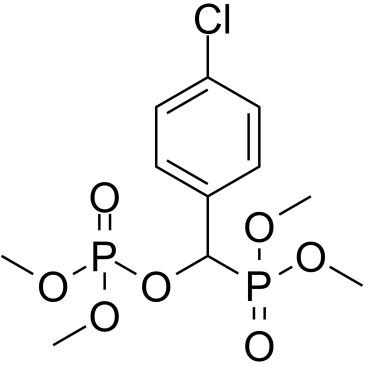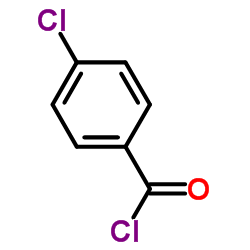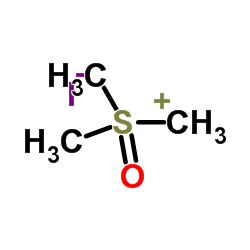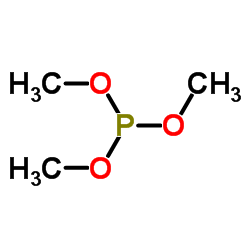76541-72-5
| 中文名 | 米福贝特 |
|---|---|
| 英文名 | [(4-chlorophenyl)-dimethoxyphosphorylmethyl] dimethyl phosphate |
| 中文别名 |
米福酯
(4-氯苯基)(二甲氧基膦)甲基磷酸二甲酯 |
| 英文别名 |
Clenicor
SR-202 Mifobate |
| 描述 | Mifobate (SR-202) 是一种有效且特异性的 PPARγ 拮抗剂,可选择性的抑制噻唑烷二酮 (TZD) 诱导的 PPARγ 转录活性 (IC50=140 μM)。Mifobate 不影响 PPARα,PPARβ 或 FXR 的基础或配体刺激的转录活性。Mifobate 具有抗肥胖和抗糖尿病作用。 |
|---|---|
| 相关类别 | |
| 靶点 |
PPARγ:140 μM (IC50) |
| 体外研究 | 米非特(100-400μM;24小时预处理)显著抑制6天后BRL 49653-和激素诱导的3T3-L1细胞脂肪细胞分化,呈剂量依赖性[1]。MIFOBATE能够与PPARγ特异性相互作用,并抑制其与共激活剂类固醇受体共激活因子-1(SRC-1)的激动剂依赖性相互作用。米非特(SR-202)抑制TZD刺激的促活化激素受体辅活化因子-1的募集。米非特阻断噻唑烷二酮类或地塞米松、胰岛素和3-异丁基-1-甲基黄嘌呤(IBMX)联合诱导的脂肪细胞分化[1]。 |
| 体内研究 | 米非特(400 mg/kg;喂养20天)提高ob/ob小鼠的胰岛素敏感性[1]动物模型:8周龄雄性ob/ob小鼠[1]剂量:400 mg/kg给药:饲料(食物混合液维持20天)结果:阻止葡萄糖浓度随时间的增加。 |
| 参考文献 |
| 密度 | 1.355g/cm3 |
|---|---|
| 沸点 | 436.6ºC at 760 mmHg |
| 分子式 | C11H17ClO7P2 |
| 分子量 | 358.64900 |
| 闪点 | 350.8ºC |
| 精确质量 | 358.01400 |
| PSA | 99.91000 |
| LogP | 4.24200 |
| 外观性状 | 白色至灰白色的粉末或晶体 |
| 折射率 | 1.494 |
| 储存条件 | -20°C,密封,干燥 |
|
Section1. IDENTIFICATION OF THE SUBSTANCE/MIXTURE Product identifiers Product name: SR-202 CAS-No.: 76541-72-5 Relevant identified uses of the substance or mixture and uses advised against Identified uses: Laboratory chemicals, Manufacture of substances Section2. HAZARDS IDENTIFICATION Classification of the substance or mixture Not a hazardous substance or mixture according to Regulation (EC) No 1272/2008 This substance is not classified as dangerous according to Directive 67/548/EEC. Label elements The product does not need to be labelled in accordance with EC directives or respective national laws. Other hazards - none Section3. COMPOSITION/INFORMATION ON INGREDIENTS Substances : Dimethyl (α-dimethoxyphosphinyl-p-chlorobenzyl) phosphate Synonyms Mifobate Formula: C11H17ClO7P2 C11H17ClO7P2 Molecular Weight: 358,65 g/mol Section4. FIRST AID MEASURES Description of first aid measures General advice Consult a physician. Show this safety data sheet to the doctor in attendance. If inhaled If breathed in, move person into fresh air. If not breathing, give artificial respiration. Consult a physician. In case of skin contact Wash off with soap and plenty of water. Consult a physician. In case of eye contact Flush eyes with water as a precaution. If swallowed Never give anything by mouth to an unconscious person. Rinse mouth with water. Consult a physician. Most important symptoms and effects, both acute and delayed To the best of our knowledge, the chemical, physical, and toxicological properties have not been thoroughly investigated. Indication of any immediate medical attention and special treatment needed no data available Section5. FIREFIGHTING MEASURES Extinguishing media Suitable extinguishing media Use water spray, alcohol-resistant foam, dry chemical or carbon dioxide. Special hazards arising from the substance or mixture Carbon oxides, Oxides of phosphorus, Hydrogen chloride gas Advice for firefighters Wear self contained breathing apparatus for fire fighting if necessary. Further information no data available Section6. ACCIDENTAL RELEASE MEASURES Personal precautions, protective equipment and emergency procedures Use personal protective equipment. Avoid dust formation. Avoid breathing vapors, mist or gas. Avoid breathing dust. Environmental precautions Do not let product enter drains. Methods and materials for containment and cleaning up Pick up and arrange disposal without creating dust. Sweep up and shovel. Keep in suitable, closed containers for disposal. Reference to other sections For disposal see section 13. Section7. HANDLING AND STORAGE Precautions for safe handling Avoid formation of dust and aerosols. Provide appropriate exhaust ventilation at places where dust is formed.Normal measures for preventive fire protection. Conditions for safe storage, including any incompatibilities Store in cool place. Keep container tightly closed in a dry and well-ventilated place. Recommended storage temperature: -20 °C Air sensitive. Store with desiccant. Specific end uses no data available Section8. EXPOSURE CONTROLS/PERSONAL PROTECTION Control parameters Components with workplace control parameters Exposure controls Appropriate engineering controls Handle in accordance with good industrial hygiene and safety practice. Wash hands before breaks and at the end of workday. Personal protective equipment Eye/face protection Use equipment for eye protection tested and approved under appropriate government standards such as NIOSH (US) or EN 166(EU). Skin protection Handle with gloves. Gloves must be inspected prior to use. Use proper glove removal technique (without touching glove's outer surface) to avoid skin contact with this product. Dispose of contaminated gloves after use in accordance with applicable laws and good laboratory practices. Wash and dry hands. The selected protective gloves have to satisfy the specifications of EU Directive 89/686/EEC and the standard EN 374 derived from it. Body Protection Choose body protection in relation to its type, to the concentration and amount of dangerous substances, and to the specific work-place., The type of protective equipment must be selected according to the concentration and amount of the dangerous substance at the specific workplace. Respiratory protection Respiratory protection is not required. Where protection from nuisance levels of dusts are desired, use type N95 (US) or type P1 (EN 143) dust masks. Use respirators and components tested and approved under appropriate government standards such as NIOSH (US) or CEN (EU). Section9. PHYSICAL AND CHEMICAL PROPERTIES Information on basic physical and chemical properties a) AppearanceForm: crystalline b) Odourno data available c) Odour Thresholdno data available d) pHno data available e) Melting point/freezingno data available point f) Initial boiling point and no data available boiling range g) Flash pointno data available h) Evaporation rateno data available i) Flammability (solid, gas) no data available j) Upper/lowerno data available flammability or explosive limits k) Vapour pressureno data available l) Vapour densityno data available m) Relative densityno data available n) Water solubilityno data available o) Partition coefficient: n- no data available octanol/water p) Autoignitionno data available temperature q) Decompositionno data available temperature r) Viscosityno data available s) Explosive propertiesno data available t) Oxidizing propertiesno data available Other safety information no data available Section10. STABILITY AND REACTIVITY Reactivity no data available Chemical stability no data available Possibility of hazardous reactions no data available Conditions to avoid no data available Incompatible materials Strong oxidizing agents Hazardous decomposition products Other decomposition products - no data available Section11. TOXICOLOGICAL INFORMATION Information on toxicological effects Acute toxicity LD50 Oral - rat - 3.200 mg/kg Skin corrosion/irritation no data available Serious eye damage/eye irritation no data available Respiratory or skin sensitization no data available Germ cell mutagenicity no data available Carcinogenicity IARC:No component of this product present at levels greater than or equal to 0.1% is identified as probable, possible or confirmed human carcinogen by IARC. Reproductive toxicity no data available Specific target organ toxicity - single exposure no data available Specific target organ toxicity - repeated exposure no data available Aspiration hazard no data available Potential health effects InhalationMay be harmful if inhaled. May cause respiratory tract irritation. IngestionMay be harmful if swallowed. SkinMay be harmful if absorbed through skin. May cause skin irritation. EyesMay cause eye irritation. Signs and Symptoms of Exposure To the best of our knowledge, the chemical, physical, and toxicological properties have not been thoroughly investigated. Additional Information RTECS: TB8817000 Section12. ECOLOGICAL INFORMATION Toxicity no data available Persistence and degradability no data available Bioaccumulative potential no data available Mobility in soil no data available Results of PBT and vPvB assessment no data available Other adverse effects no data available Section13. DISPOSAL CONSIDERATIONS Waste treatment methods Product Offer surplus and non-recyclable solutions to a licensed disposal company. Contact a licensed professional waste disposal service to dispose of this material. Dissolve or mix the material with a combustible solvent and burn in a chemical incinerator equipped with an afterburner and scrubber. Contaminated packaging Dispose of as unused product. Section14. TRANSPORT INFORMATION UN number ADR/RID: -IMDG: -IATA: - UN proper shipping name ADR/RID: Not dangerous goods IMDG: Not dangerous goods IATA:Not dangerous goods Transport hazard class(es) ADR/RID: -IMDG: -IATA: - Packaging group ADR/RID: -IMDG: -IATA: - Environmental hazards ADR/RID: noIMDG Marine pollutant: noIATA: no Special precautions for user no data available SECTION 15 - REGULATORY INFORMATION N/A SECTION 16 - ADDITIONAL INFORMATION N/A |
CHEMICAL IDENTIFICATION
HEALTH HAZARD DATAACUTE TOXICITY DATA
|
| 个人防护装备 | Eyeshields;Gloves;type N95 (US);type P1 (EN143) respirator filter |
|---|---|
| 危害码 (欧洲) | Xi |
| 危险品运输编码 | NONH for all modes of transport |
| RTECS号 | TB8817000 |
| 海关编码 | 2931900090 |
|
~82% 
76541-72-5 |
| 文献:Nguyen; Niesor; Bentzen Journal of Medicinal Chemistry, 1987 , vol. 30, # 8 p. 1426 - 1433 |
|
~% 
76541-72-5 |
| 文献:Journal of Medicinal Chemistry, , vol. 30, # 8 p. 1426 - 1433 |
|
~% 
76541-72-5 |
| 文献:Monatshefte fuer Chemie, , vol. 111, p. 1015 - 1024 |
|
~% 
76541-72-5 |
| 文献:Phosphorus and Sulfur and the Related Elements, , vol. 25, p. 173 - 176 |
| 上游产品 5 | |
|---|---|
| 下游产品 0 | |
| 海关编码 | 2931900090 |
|---|---|
| 中文概述 | 2931900090. 其他有机-无机化合物. 增值税率:17.0%. 退税率:13.0%. 监管条件:AB(入境货物通关单,出境货物通关单). 最惠国关税:6.5%. 普通关税:30.0% |
| Summary | 2931900090. other organo-inorganic compounds. VAT:17.0%. Tax rebate rate:13.0%. Supervision conditions:AB(certificate of inspection for goods inward,certificate of inspection for goods outward). MFN tariff:6.5%. General tariff:30.0% |







